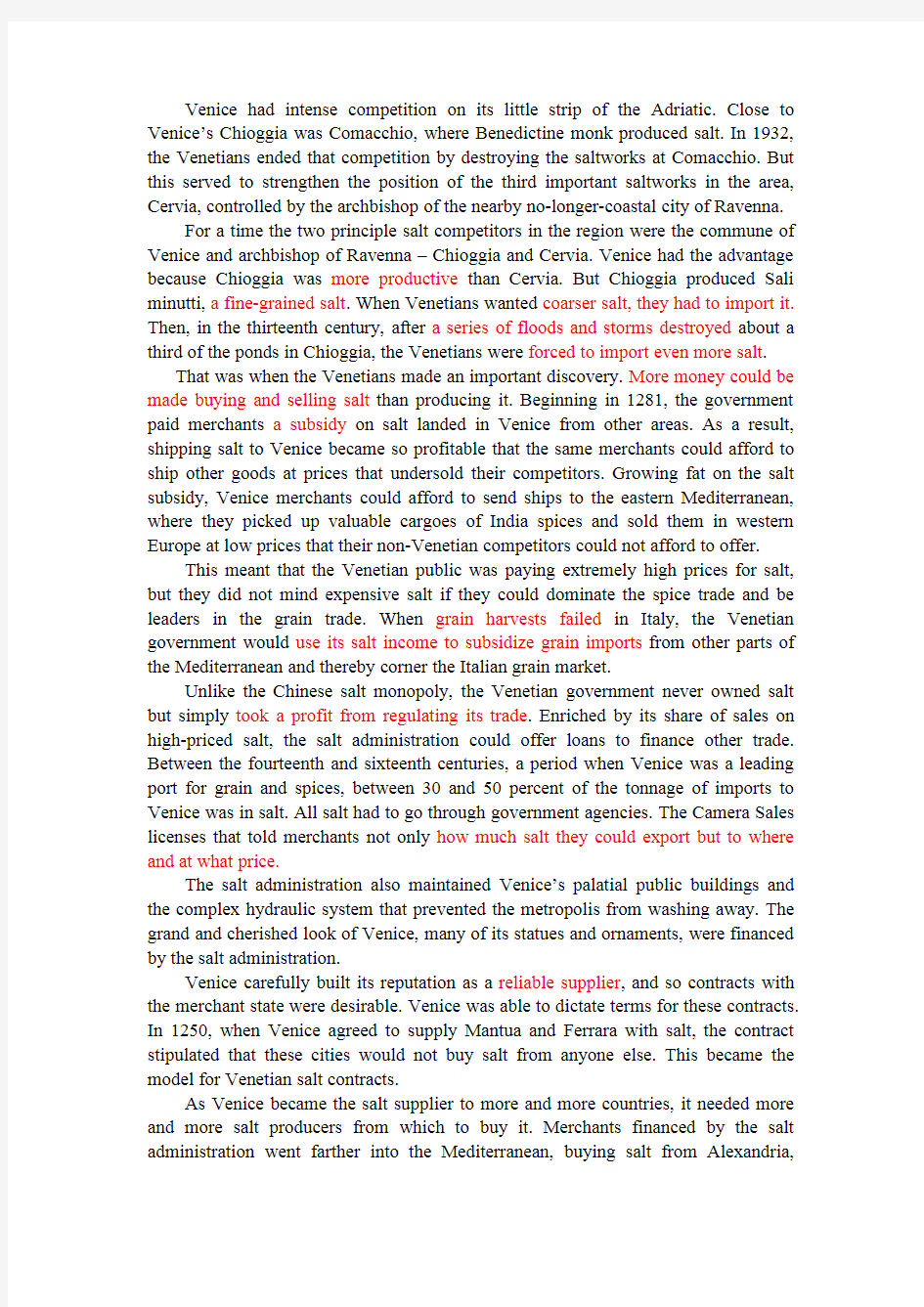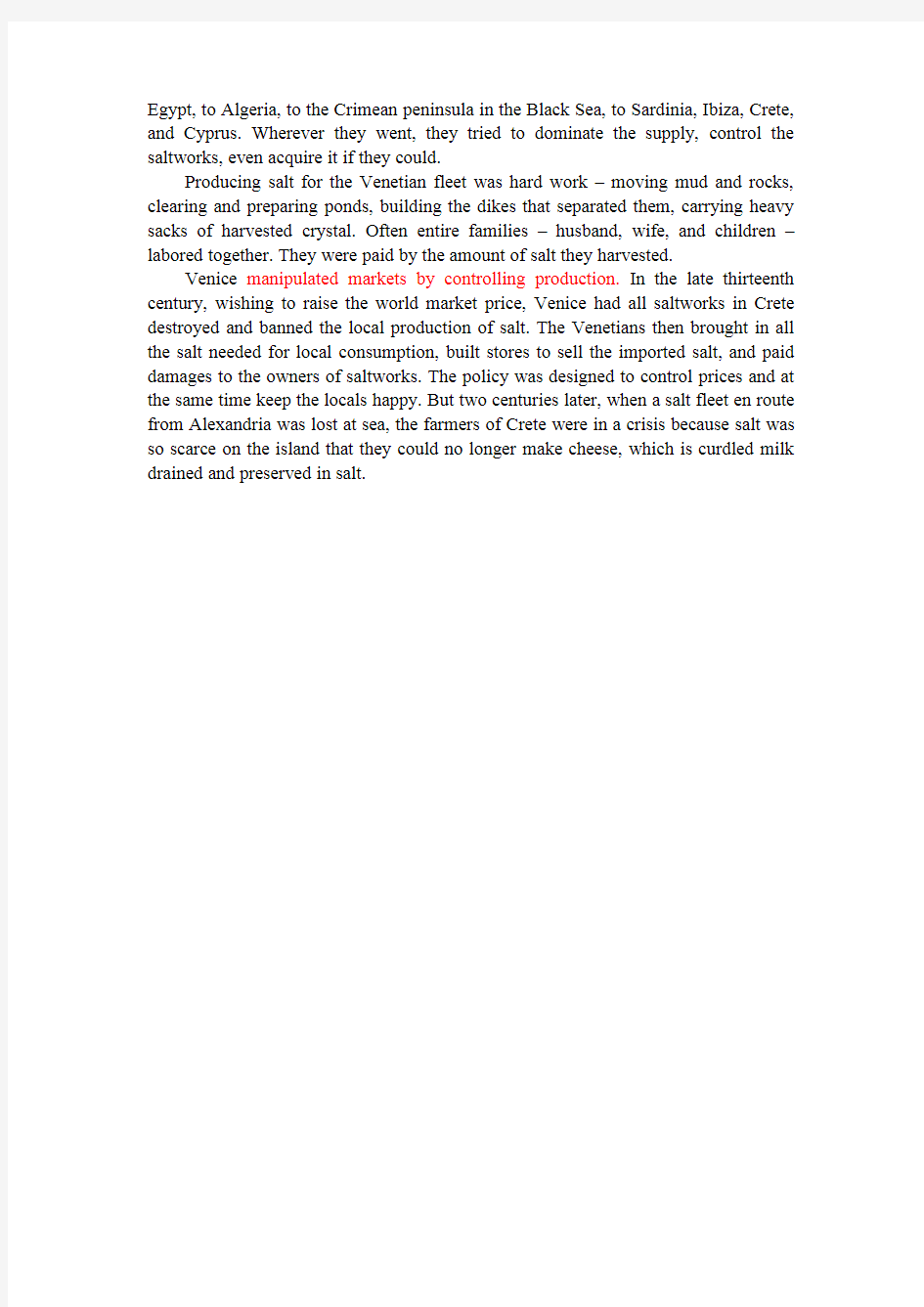托福经典加试威尼斯盐业


Venice had intense competition on its little strip of the Adriatic.Close to Venice’s Chioggia was Comacchio,where Benedictine monk produced salt.In1932, the Venetians ended that competition by destroying the saltworks at Comacchio.But this served to strengthen the position of the third important saltworks in the area, Cervia,controlled by the archbishop of the nearby no-longer-coastal city of Ravenna.
For a time the two principle salt competitors in the region were the commune of Venice and archbishop of Ravenna–Chioggia and Cervia.Venice had the advantage because Chioggia was more productive than Cervia.But Chioggia produced Sali minutti,a fine-grained salt.When Venetians wanted coarser salt,they had to import it. Then,in the thirteenth century,after a series of floods and storms destroyed about a third of the ponds in Chioggia,the Venetians were forced to import even more salt.
That was when the Venetians made an important discovery.More money could be made buying and selling salt than producing it.Beginning in1281,the government paid merchants a subsidy on salt landed in Venice from other areas.As a result, shipping salt to Venice became so profitable that the same merchants could afford to ship other goods at prices that undersold their competitors.Growing fat on the salt subsidy,Venice merchants could afford to send ships to the eastern Mediterranean, where they picked up valuable cargoes of India spices and sold them in western Europe at low prices that their non-Venetian competitors could not afford to offer.
This meant that the Venetian public was paying extremely high prices for salt, but they did not mind expensive salt if they could dominate the spice trade and be leaders in the grain trade.When grain harvests failed in Italy,the Venetian government would use its salt income to subsidize grain imports from other parts of the Mediterranean and thereby corner the Italian grain market.
Unlike the Chinese salt monopoly,the Venetian government never owned salt but simply took a profit from regulating its trade.Enriched by its share of sales on high-priced salt,the salt administration could offer loans to finance other trade. Between the fourteenth and sixteenth centuries,a period when Venice was a leading port for grain and spices,between30and50percent of the tonnage of imports to Venice was in salt.All salt had to go through government agencies.The Camera Sales licenses that told merchants not only how much salt they could export but to where and at what price.
The salt administration also maintained Venice’s palatial public buildings and the complex hydraulic system that prevented the metropolis from washing away.The grand and cherished look of Venice,many of its statues and ornaments,were financed by the salt administration.
Venice carefully built its reputation as a reliable supplier,and so contracts with the merchant state were desirable.Venice was able to dictate terms for these contracts. In1250,when Venice agreed to supply Mantua and Ferrara with salt,the contract stipulated that these cities would not buy salt from anyone else.This became the model for Venetian salt contracts.
As Venice became the salt supplier to more and more countries,it needed more and more salt producers from which to buy it.Merchants financed by the salt administration went farther into the Mediterranean,buying salt from Alexandria,
Egypt,to Algeria,to the Crimean peninsula in the Black Sea,to Sardinia,Ibiza,Crete, and Cyprus.Wherever they went,they tried to dominate the supply,control the saltworks,even acquire it if they could.
Producing salt for the Venetian fleet was hard work–moving mud and rocks, clearing and preparing ponds,building the dikes that separated them,carrying heavy sacks of harvested crystal.Often entire families–husband,wife,and children–labored together.They were paid by the amount of salt they harvested.
Venice manipulated markets by controlling production.In the late thirteenth century,wishing to raise the world market price,Venice had all saltworks in Crete destroyed and banned the local production of salt.The Venetians then brought in all the salt needed for local consumption,built stores to sell the imported salt,and paid damages to the owners of saltworks.The policy was designed to control prices and at the same time keep the locals happy.But two centuries later,when a salt fleet en route from Alexandria was lost at sea,the farmers of Crete were in a crisis because salt was so scarce on the island that they could no longer make cheese,which is curdled milk drained and preserved in salt.
